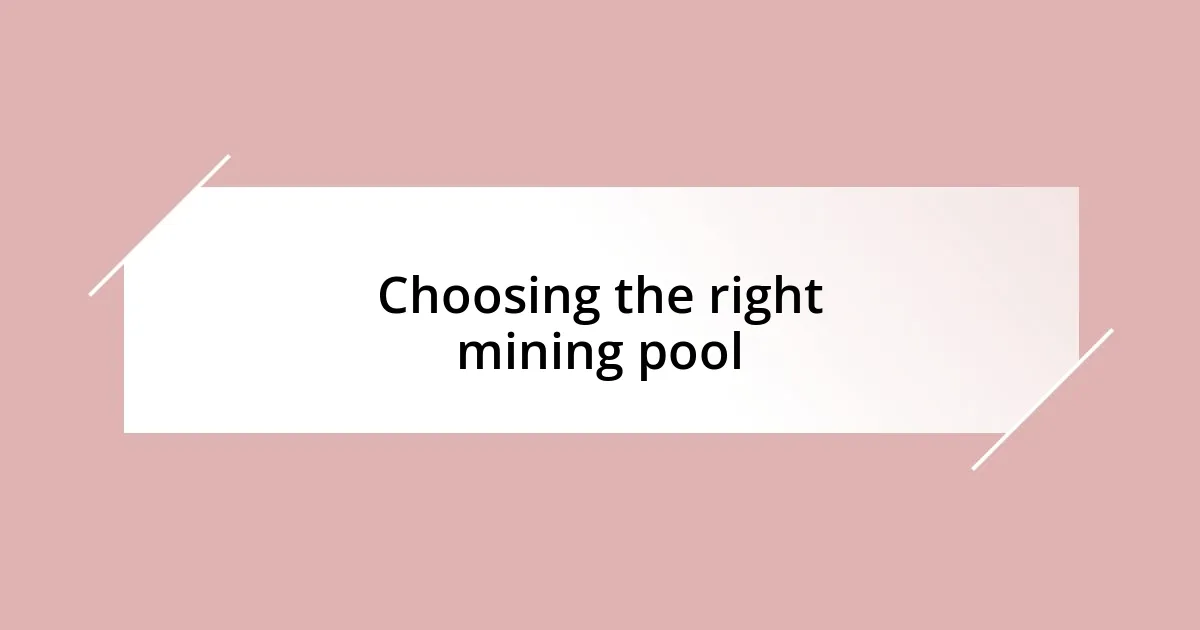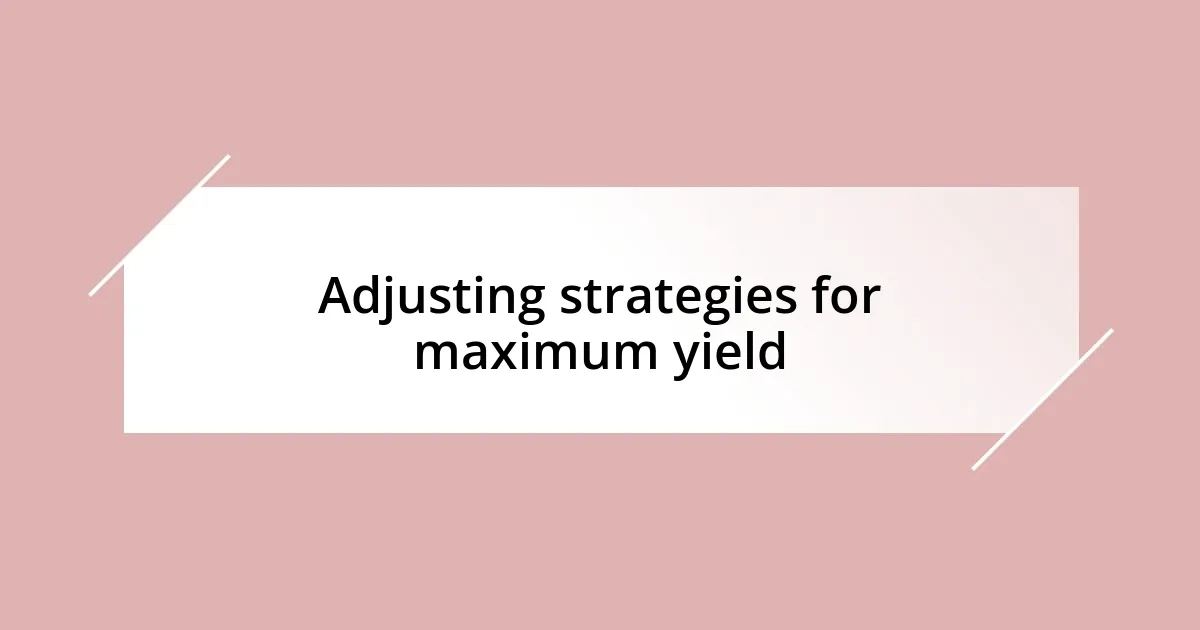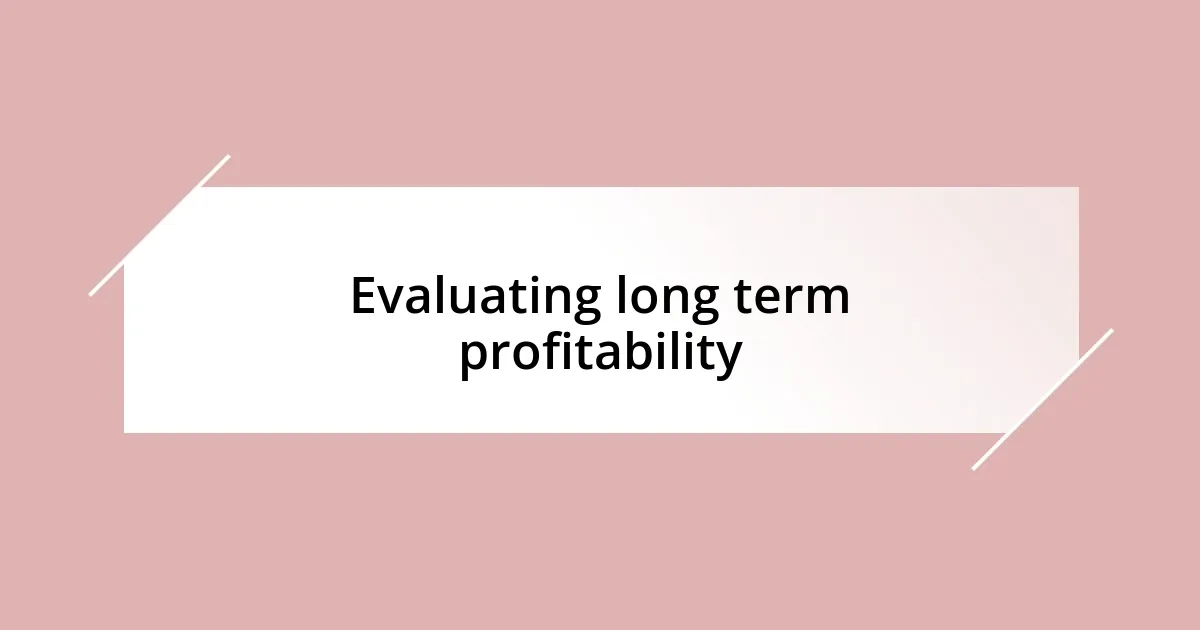Key takeaways:
- Pool mining increases efficiency by pooling resources, leading to quicker block discovery and more consistent rewards.
- Choosing the right mining pool involves analyzing factors such as pool size, payout methods, fees, and community support.
- Monitoring network difficulty and adjusting strategies based on market conditions are crucial for maximizing mining yields.
- Evaluating long-term profitability requires understanding market volatility and tracking operational costs alongside earnings.

Understanding pool mining efficiency
When I first started in pool mining, I was amazed at how much more efficient it felt compared to solo mining. The concept of pooling resources with others reduces the time it takes to find a block, which can be a game-changer. Have you ever experienced that rush of excitement when your pool hits a block and you see immediate rewards?
Efficiency in pool mining hinges on several factors, such as the pool’s hash rate and the distribution of earnings. I remember joining a smaller pool at first, thinking I’d get better rewards due to less competition. Surprisingly, it turned out the larger pools had steadier returns, which taught me that sometimes bigger really is better in this game.
It’s essential to consider how the pool distributes rewards—whether it’s pay-per-share or proportional. Personally, I prefer a pay-per-share model because it offers more predictability in earnings. Isn’t it fascinating how minor differences in reward structures can significantly impact your mining experience? Understanding these nuances not only enhances your strategy but can also heighten your enjoyment of the entire process.

Choosing the right mining pool
Choosing the right mining pool can feel daunting, especially with so many options available. I vividly recall the first time I decided on a pool; I spent hours reading reviews and scouring forums. The excitement was palpable—finding the right fit felt like choosing the perfect team, one you believe can really go the distance together.
Here are a few key factors to consider when selecting a mining pool:
- Pool Size: Larger pools may offer lower variance in payouts and more consistent rewards.
- Payout Methods: Understand how earnings are distributed—whether through pay-per-share, proportional, or pay-per-last-N-shares models.
- Fees: Always check the fee structure; lower fees can boost overall profitability.
- Stability and Reputation: Research the pool’s history and reliability—fewer downtimes mean higher efficiency.
- Community and Support: A strong community can provide valuable insights and help when you face challenges.
When I reflected on my journey, I recognized that settling on a mining pool was not just about the numbers; it was about finding a community that resonated with me. The feeling of connecting with like-minded miners, sharing tips, and celebrating wins together turned out to be incredibly fulfilling.

Analyzing pool payouts and fees
Analyzing the payouts and fees within a mining pool is critical to maximizing your efficiency and returns. I remember my early days in mining when I overlooked transaction fees, assuming they would be insignificant. It wasn’t until I received my first payout that I realized those fees can take a decent chunk out of my earnings. It’s essential to scrutinize these cost structures—some pools might seem appealing with low fees initially, but additional hidden costs can creep up.
The method of payout also influences your income. I once switched to a pool with a pay-per-share structure during a particularly low-yield period. It felt like a safety net, as I received small, consistent payouts regardless of when the group found blocks. It taught me the value of understanding not just how much I could potentially earn, but also how and when those funds would be available to me. Reliable timing in payouts can be just as important as the amounts themselves.
When comparing pools, it’s vital to weigh both their fees and distribution methods side by side. Here’s a handy table to visualize some averages from various pools I explored:
| Pool Name | Fees (%) | Payout Method |
|---|---|---|
| Pool A | 1.0 | Pay-Per-Share |
| Pool B | 0.5 | Proportional |
| Pool C | 1.5 | Pay-Per-Last-N-Shares |
This table reflects my experiences with several pools, helping me quickly identify that lower fees could enhance my overall profitability, but I also needed to align the payout method with my personal risk tolerance and financial goals. Have you scrutinized your pool’s fee and payout structure lately? It might reveal insights that could change your mining experience for the better.

Optimizing hardware for mining
When it comes to optimizing hardware for mining, there’s no one-size-fits-all approach. I remember modifying my setup when the latest GPUs hit the market, and it felt like unboxing a new toy with endless potential. The difference in hash rates was breathtaking; it underscored how even slight upgrades can lead to significant improvements in mining efficiency. The key here is to regularly assess your hardware capabilities and stay informed about newer models and their performance metrics.
Cooling is another critical aspect that often gets overlooked. I once underestimated how heat could affect my mining rig’s longevity. After a few weeks of relentless processing, I noticed a decrease in output, prompting me to invest in additional cooling fans. The moment I saw my hardware running optimally again was a relief—it’s astonishing how maintaining a lower temperature can enhance performance while prolonging hardware lifespan. Have you thought about how temperature management could impact your mining efficiency?
Lastly, power supply is something I’ve learned to prioritize. It’s easy to focus on just the GPUs and CPUs, but a reliable power supply can make or break your mining setup. Early on, I experienced a harrowing blackout that nearly fried my rig. That mistake pushed me to invest in a UPS (Uninterruptible Power Supply). This not only protects my equipment but also ensures consistent performance. Remember, you can have top-of-the-line hardware, but if your power setup is shaky, your mining efficiency will suffer. Have you considered how your power supply choices can empower your overall operations?

Monitoring network difficulty changes
Monitoring network difficulty changes is like keeping a pulse on your mining operations. When I first started mining, I didn’t pay much attention to this aspect. I was surprised to learn that as more miners join the network, the difficulty level increases, which can affect my earnings. It’s crucial to track these changes regularly so I can adjust my strategies accordingly.
I remember one instance when the difficulty spiked unexpectedly. I had to make quick decisions, considering whether to stay in my current pool or find one with better terms during that challenging period. This experience taught me that monitoring network difficulty isn’t just about numbers; it impacts my overall profitability and mindset. How many times have you adjusted your strategy based on such changes?
To effectively monitor these fluctuations, I found online tools and community forums incredibly helpful. They provide real-time updates and forecasts, allowing me to stay ahead of the game. Having this knowledge at my fingertips has not only improved my mining efficiency but also boosted my confidence in my decision-making. Have you explored using such resources? They can offer insights that might make a significant difference in your mining outcomes.

Adjusting strategies for maximum yield
Adjusting my mining strategies for maximum yield often feels like fine-tuning a musical instrument. There was a time when I stubbornly stuck to my initial plan, believing it would yield the best results. However, as I experimented with different configurations in response to fluctuating difficulty levels, I realized that flexibility is key. A simple tweak in my pooling strategy or a shift in my mining focus can elevate my returns significantly. Have you ever considered how a slight change in your approach could lead to unexpected gains?
I remember a specific situation where I had been mining a particular coin diligently but noticed a drop in profitability. Instead of letting frustration set in, I took a step back and did some analysis. I discovered that a similar coin had a much lower difficulty at that moment due to market variations. After switching my focus, I felt a rush of satisfaction as I saw my yield climb back up. This taught me the importance of not just sticking to a single mining strategy but remaining open to exploring alternative paths. How often do you reassess your mining choices?
Also, staying engaged with the mining community has truly enhanced my ability to adjust strategies quickly. Through forums and social media groups, I picked up invaluable tips and trends that I might have missed alone. I recall a discussion about the benefits of switching pools based on profit-sharing models, which led me to a more lucrative setup. It’s fantastic how collective knowledge can drive better decision-making in individual operations. Have you tapped into community insights? They can often illuminate paths you hadn’t considered.

Evaluating long term profitability
Evaluating long-term profitability in pool mining goes beyond just keeping an eye on current metrics; it’s about predicting future viability. When I first considered the longevity of my mining endeavors, I didn’t fully appreciate how external market factors play a significant role in profitability. For instance, after experiencing a sudden drop in my mined coin’s value, I had to reflect on how these fluctuations could impact my finances in the long run. Have you paused to think about how market volatility could influence your mining success over time?
As I dived deeper into financial analysis, I realized that understanding the historical performance of the coins I was mining helped me paint a clearer picture. When I first began, I was drawn to shiny new coins without considering their long-term potential. I remember the disappointment when one of those coins plummeted shortly after I invested time and resources into mining it. Focusing on coins with a stable history or upward trend has shifted my strategy dramatically. Have you ever looked back at your past choices and wished you had prioritized stability over novelty?
In my quest for long-term profitability, I actively track operational costs alongside potential earnings. This balance is crucial, as hidden costs such as electricity and pool fees can eat away at your profits. I vividly recall a month when unforeseen spikes in my electricity bill made a dent in my returns. It was a learning moment that reminded me to calculate every expense and factor it into my profitability analysis. Have you taken the time to dissect your mining costs thoroughly? Understanding each element can lead to more informed decisions and, ultimately, greater success.














